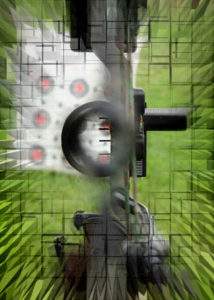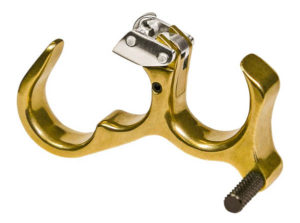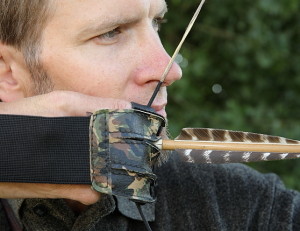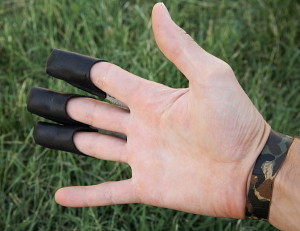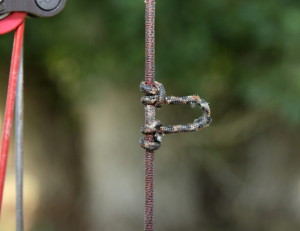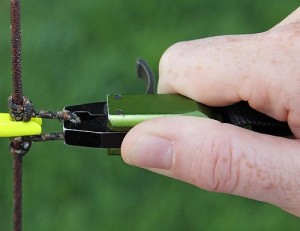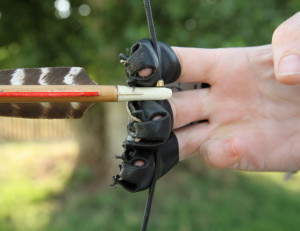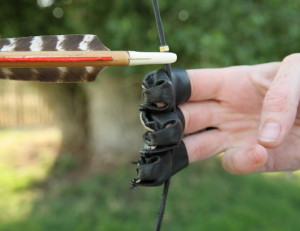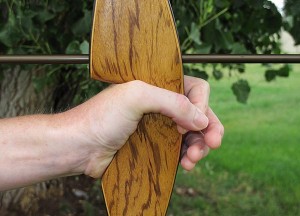Like many archers, I’ve struggled with occasional bouts of target panic over the years. After trying just about everything to cure target panic, I’ve found that some techniques work better than others. In this article we’ll focus on the five best cures for target panic.
What is Target Panic?
What’s so scary about targets that we might panic? Target panic is a breakdown of the natural shot process caused by bad shooting habits. Simply put, it’s a fight or flight response to the pressure of hitting the bullseye. When a victim of target panic tries to acquire the bullseye, he either rushes the shot or fails to settle the pin without panicking.
What Causes Target Panic?
The worst contributor to TP is punching the trigger on a release aid. Shooting a heavy bow beyond fatigue can also lead to TP. A third contributor is mental stress from shooting competitive archery.
When an archer develops bad shooting habits (like punching the trigger), he begins to miss the bullseye. The more he misses, the more he tries to control the shot. Pretty soon this stress turns into a full-on panic. Just holding the pin on the bullseye becomes a physically impossibility. In extreme cases the archer is physically incapable of even raising his sight pin to the bullseye no matter how hard he tries.
Anyone who shoots regularly can develop target panic. Target panic is a maddening condition that wrecks ones confidence and can last for years if left untreated.
The goal of these exercises is retrain your brain not to react to a shot. This article focuses on compound shooters, but applies to traditional shooters as well.
Best Cures for Target Panic
- Use a back tension release. You can literally cure target panic in one day by using a back tension release aid. A back-tension release has an adjustable, hinged hook that rotates with your elbow during the shot process. As your shoulder blades squeeze together, the shot eventually breaks naturally. There is no physical way to trigger the release without pulling through the shot using your back. Unlike finger releases, the back-tension release creates a surprise release with every shot. Finger releases are great for hunting, but can cause target panic. Back tension releases are fully adjustable to your desired shot sequence. There are several good models on the market, but the one I used is called the Scott Longhorn Pro Micro.
- Hold on the Bullseye, then Let Down. This is a very simple, yet effective technique. It won’t cure target panic in a day, but it will gradually retrain your brain to hold on the bullseye without stress. Simply draw your bow, let the pin float on the bullseye for a few seconds, and then let down. Whatever you do, don’t shoot! Do this drill several times per session. After a week or two start releasing an arrow with every other draw. If stress creeps back into the shot, start over. Eventually you’ll be able to release the arrow without stress. It’s important not to hold the draw too long or you’ll fatigue out, which only exasperates target panic. It’s never a good idea to keep shooting after exhausting your muscles.
- Shoot a Giant Bullseye. Basically you create a huge bullseye out of paper or cardboard and pin it to your target. Shoot the big bullseye from just 10 yards away. Similar to blank bale shooting—where there is no bullseye—this drill is designed to take your focus off aiming, and focus instead on what a surprise release feels like. Be sure to use your back and not your fingers to trigger the release. Gradually reduce the size of the bullseye until you can shoot normally again.
- Shoot a Lighter-Draw Bow. A lighter bow removes all the physical stress involved with shooting. Shooting a very heavy-to-draw bow creates physical stress and can lead to target panic. Basically as you fatigue out your mind gets anxious to get rid of the stress. Pretty soon you’re rushing the shot instead of pulling through smoothly. During the off-season I switch to a bow that’s 15 pounds lighter than my hunting bow. I did this initially to save my shoulder, but it has the added benefit of letting me shoot longer sessions without fatigue.
- Use a Longer Stabilizer. A long stabilizer on the front of your bow creates resistance to movement at full draw. The longer the stabilizer, the less movement. This is why you see tournament archers with ridiculously long stabilizers protruding three or four feet in front of their bows. For our purposes you’ll do just fine with a 12-inch stabilizer. A person struggling with target panic is prone to quick, jerky movements towards the bullseye. A long stabilizer resists these movements. Once you settle the pin on the bullseye, it stays longer. Whichever stabilizer you choose, just make sure the weight is out front. You don’t want a big, bulky stabilizer that will just add more weight to your bow. The B-Stinger is a great option and even comes with extra weights for customization. Or you could always make your own out of an old carbon arrow and weights found on eBay.
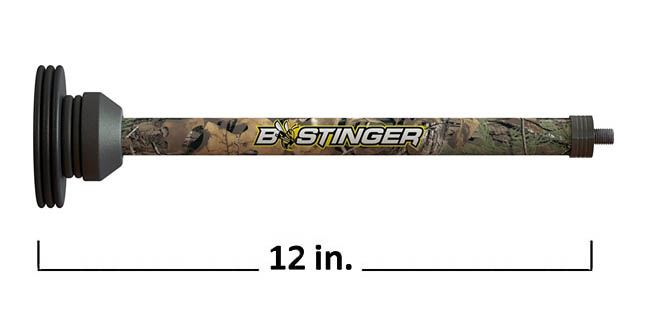
A stabilizer measureing 12″ or more, and with front weights, will your bow help you stay on target.
A Final Note
The goal of these exercises is to relearn how draw to a relaxed state of mind and body. There are three ways to help you do this. First, don’t hold your breath. Archers oftentimes hold their breath when they draw, but that just adds more stress to the shot. Second acquire the bullseye quickly. Moving your pin slowly to the bullseye creates anticipation. And third, tell yourself it’s okay to miss. Miss on purpose if you have to, but teach your brain that it’s okay to miss occasionally.
Conclusion
If you’ve implemented these five steps then congratulations, you’re cured! If not, start over. Most archers will struggle with bouts of target panic now and then, but don’t panic, it’s easily cured.
You can avoid future bouts by practicing proper shooting techniques. Always strive to use your back muscles and have a surprise release with every shot. Avoid shooting a heavy bow beyond the point of fatigue. Instead use a light-draw bow with a long stabilizer during the off-season. A heavy bow turns archery a high stress activity when it should be fun and relaxing.
I hope this helps. Let me know if you have any questions and happy shooting.

